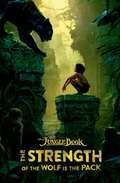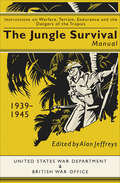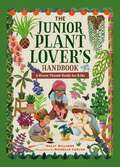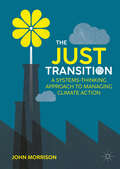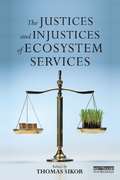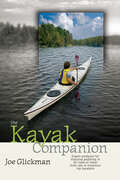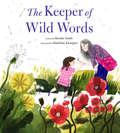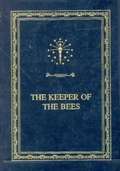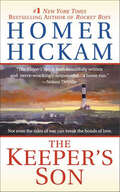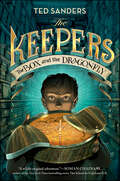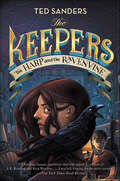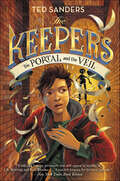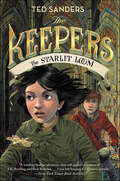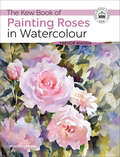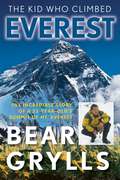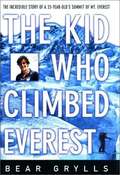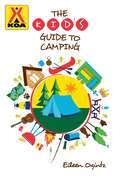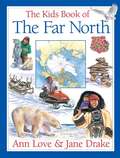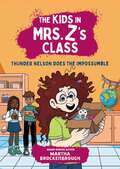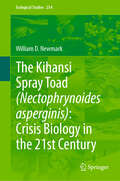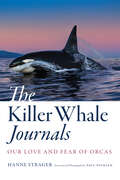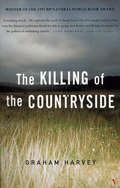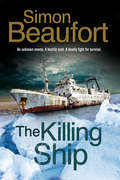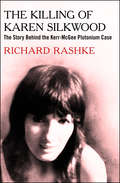- Table View
- List View
The Jungle Book: Classics Illustrated
by Rudyard Kipling Ángel DomínguezMowgli movie fans will fall in love with this beautifully illustrated classic!Since its inception in 1894, The Jungle Book has enchanted readers—both young and old—with its invaluable moral lessons. By bestowing the animals in the stories with human traits, famed writer Rudyard Kipling gives readers timeless parables that teach family values and the importance of community.The most popular of these tales center on Mowgli, a young boy who lives in the jungle amongst a community of animals. All before reaching his teenage years, he is brought up by wolves, trained by a bear, kidnapped by monkeys, and much more. This collection also features other classic stories, most notably “Rikki Tikki Tavi,” a story of a young mongoose named Rikki, who serves as a protector from dangerous cobras for a British family residing in India. In this masterful tale, the young mongoose is forced into a ferocious battle with Nagaina, a large venomous cobra threatening Rikki’s family and seeking revenge for the death of her counterpart, Nag. These stories, with their vibrant characters and important moral lessons, have stood the test of time, having been reprinted in hundreds of different versions and languages around the world.Between the First and Second Jungle Books, this volume contains every single original Mowgli story. Featuring stunning, all-new illustrations by renowned artist Ángel Domínguez, this version of Kipling’s masterpiece is a beautiful edition sure to continue to educate and inspire readers for decades to come.
The Jungle Book: The Strength of the Wolf is the Pack (Disney)
by Scott Peterson Joshua Pruett<p>"THIS IS THE LAW OF THE JUNGLE, AS OLD AND AS TRUE AS THE SKY. . . ." <p>Mowgli has lived in the Jungle for as long as he can remember. Raised by a noble wolf pack and mentored by a wise panther called Bagheera, Mowgli enjoys the rich, vibrant world of the animals. And while at times it is clear he doesn't quite fit in, he could never imagine leaving it. <p>But when a vengeful tiger makes a vow to remove the man-cub from the Jungle, Mowgli's world is turned upside down. With help from his new friend Baloo the bear, Mowgli finds himself on a journey to protect his wolf family and himself--a journey that could change things forever. <p>Will the man-cub be able to find his place in the Jungle?</p>
The Jungle Survival Manual 1939-1945: Instructions on Warfare, Terrain, Endurance and the Dangers of the Tropics
by Alan JeffreysThe army guide that taught WWII soldiers how to survive in the jungles and swamps of the tropics.During the Second World War, Allied soldiers fought to survive not only encounters with the enemy but the landscape they found themselves in. Being posted to Southeast Asia and the Pacific to fight the Japanese meant soldiers had to learn to survive in the tropics, fighting and living in endless steamy jungle and perilous swamps. In this alien environment, men had to be able to take care of themselves rather than relying on their unit to supply their needs, something that did not come naturally to the many soldiers born and raised in cities.To help them, the British and US armies produced a number of official training manuals and guides explaining how to identify and fight the Japanese and avoid their deadly punji traps, as well as “jungle lore”: How to find and cook plants that were safe to eat Which animals and insects could kill them How to identify and treat tropical illnesses and diseases How to avoid the dangers of polluted water and cannibalsThe Jungle Survival Manual brings together the official manuals and information that enabled the Allies to fight in Burma, Malaya, Thailand, Indochina, Singapore, and the Pacific Islands—and win the war.Includes diagrams and drawings reproduced from the original guides.
The Junior Plant Lover's Handbook: A Green-Thumb Guide for Kids (The Junior Handbook Series)
by Molly WilliamsAn interactive, illustrated guide perfect for any burgeoning plant lover! Research shows plants can keep us (and our living spaces) happier and healthier. This illustrated guide breaks down everything from basic light and water needs to soil and temperature requirements for over fifty plants, and will help you find the right plant(s) for your personality, regardless of where you live or how much space you have. With an expansive glossary of plant terms, you&’ll be speaking like a horticulture pro in no time. Each section includes: &“How To&” instructions for planting and caring for greenery Fun plant facts Troubleshooting tips Interactive quizzes Informative, handy charts DIY crafts and projects
The Just Transition: A Systems-Thinking Approach To Managing Climate Action
by John MorrisonManaging the climate transition will be one of the biggest challenges ever faced by business and government. While the technical and financial elements of climate transition are vast, the social challenges are even greater. If local populations and workers feel the transitions are not “just” they will resist, and that social opposition now represents one of the greatest barriers to reaching Net Zero by 2050. While the phrase ‘Just Transition’ was in the preamble to the 2015 Paris Climate Agreement, it is only now that business, finance and governments are starting to discuss what this might mean in practice. Thousands of companies are now starting to develop transition plans alongside those of governments. This book shows how all managers can best integrate social elements into these plans, consult with the people most affected by the transition out of the high carbon economy, and ensure that what looks good on paper works in practice. It takes a systems-thinking approach, focusing on the interconnections and interdependence of environmental, social and governance issues. The challenge is immense, and the changes will need to be profound. Each chapter in the book will look at the main domains in which management and policy challenges will be faced. From massively increasing the extraction of rare earth metals, most of which sit below, or adjacent to, indigenous land, to building the infrastructure needed to generate and distribute green energy, possibly over “Not in My Back Yard’ objections, the task of business and government in ensuring that these changes are fair, and perceived as fair, is immense. This book provides the roadmap for how to get there. Managing the social impacts of the climate transition will be one of the biggest challenges ever faced by business and government.
The Justices and Injustices of Ecosystem Services (Routledge Studies in Ecosystem Services)
by Thomas SikorHumankind benefits from a multitude of resources and processes that are supplied by ecosystems, and collectively these benefits are known as ecosystem services. Interest in this topic has grown exponentially over the last decade, as biologists and economists have tried to quantify these benefits to justify management interventions. Yet, as this book demonstrates, the implications for justice and injustice have rarely been explored and works on environmental justice are only now addressing the importance of ecosystem services. The authors establish important new middle ground in arguments between conservationists and critics of market-based interventions such as Payment for Ecosystem Services. Neither can environmental management be separated from justice concerns, as some conservationists like to believe, nor is it in fundamental opposition to justice, as critics like to put it. The book develops this novel interpretation of justice in environmental management through analyses of prominent governance interventions and the conceptual underpinnings of the ecosystem services framework. Key examples described are revenue-sharing around protected areas and REDD+ for forest ecosystems. The analyses demonstrate that interventions create opportunities for enhancing social justice, yet also reveal critical design features that cause ostensibly technical interventions to generate injustices.
The Kayak Companion: Expert guidance for enjoying the paddling experience in water of all types from one of America's premier kayakers
by Joe GlickmanGet paddling! Joe Glickman, a two-time member of the US National Marathon Kayak Team, fills this kayaking primer with expert advice and plenty of encouragement. Beginners will benefit from Glickman’s clear descriptions of the basic techniques of sea, touring, and recreational kayaking, while experienced kayakers will find insightful tips on navigation, troubleshooting, and boat assessment. Enlivened by delightful stories of Glickman’s personal kayaking adventures, this fun and informative guide will inspire kayakers of all types to get out on the water and enjoy the ride.
The Keeper of Wild Words: (nature For Kids, Exploring Nature With Children)
by Brooke SmithA touching tale of a grandmother and her granddaughter exploring and cherishing the natural world.Words, the woods, and the world illuminate this quest to save the most important pieces of our language—by saving the very things they stand for.When Mimi finds out her favorite words—simple words, like apricot, blackberry, buttercup—are disappearing from the English language, she elects her granddaughter Brook as their Keeper. And did you know? The only way to save words is to know them.• With its focus on the power of language and social change, The Keeper of Wild Words is ideal for educators and librarians as well as young readers.• For any child who longs to get outside and learn more about nature and the environment• A loving portrait of the special relationship that grandparents have with their grandchildrenFor children who love such books as Outside Your Window: A First Book of Nature, And Then It's Spring, and Finding Wild.Brooke Smith is a poet and children's book author. She lives in Bend, Oregon, at the end of a long cinder lane. Brooke writes daily from her studio, looking at the meadow and many of the wild words she cherishes.Madeline Kloepper is a Canadian artist with a Bachelor of Fine Arts and Major in Illustration from Emily Carr University of Art and Design. Her work is influenced by childhood, nostalgia, and the relationships we forge with nature. She lives in Prince George, British Columbia.
The Keeper of the Bees
by Gene Stratton-PorterJamie MacFarlane is a wounded World War I veteran who is faring badly in the hospital. When he overhears a discussion of his case and the decision that he be sent to a sanitarium, he flees and eventually stumbles upon a beautiful garden and a small house near the Pacific Ocean. the old man who lives there is even more ill than Jamie, who helps him. As he is leaving for the hospital, the old man asks Jamie to stay and look after his bees. Thus begins a story of love, healing, and adventure for Jamie. He meets the neighbors, especially a woman named Margaret Cameron who kept house for the old man--or the Bee Master as he is called. An even more intriguing character is a child known as the little Scout, whom the bee master has taught all about bees and who is a great help to Jamie. Part of the story is the mystery of whether this child, sensitive yet brash, athletic yet somehow delicate, is a boy or a girl. Then one night, while sitting on a rock near the ocean, Jamie meets a woman in distress. she needs a marriage certificate and a name for an unborn child. believing that he will soon die anyway, and drawn to the storm woman, Jamie offers himself as her temporary husband. He promises not to try to find her later. But after the hurried wedding he cannot stop thinking of her. This is an old-fashioned romance, filled with the love of God and nature, a love story and a mystery of sorts. It is interesting to contemplate the values the author discusses through this novel, written in the nineteen twenties, and to wonder how those values are viewed today. there is also a lot of fun and some excitement, but for the most part this is a gentle and spiritual tale.
The Keeper's Son (Josh Thurlow #1)
by Homer HickamA Coast Guard commander faces Nazi aggression in American waters in this “beautifully written and nerve-wrackingly suspenseful” novel of WWII (Nelson DeMille).North Carolina, 1941. Among the wind-swept Outer Banks, Killakeet Island is home to a peaceful community of fishermen, clam stompers, oyster rakers, and a few lonely Coast Guard sailors. Dominating the tiny island landscape is the majestic Killakeet Lighthouse, which has been overseen by the Thurlow family for generations. But now Josh Thurlow, the Keeper’s son, has chosen another path . . .Seventeen years ago, Josh lost his younger brother at sea. Still wracked with guilt, he searches relentlessly for him as commander of a Coast Guard patrol boat. But Josh’s obsession with the past is complicated by the arrival of a beautiful stranger—and a foreign enemy. In Killakeet to escape the outside world, Dosie Crossan has stirred Josh’s heart. Meanwhile, a wolfpack of German U-boats has arrived to soak the island’s beaches with blood and oil.One of the U-boats is captained by the infamous Nazi warrior Otto Krebs. But Krebs has brought more than torpedoes to Killakeet. He may also have the answer to the mystery that haunts Josh Thurlow.
The Keepers: Masterminds And The Keepers: The Box And The Dragonfly (Keepers #1)
by Ted SandersExperience the fantastic adventure filled with magical objects, secret sects, and life as we know it on the line! Mixing magic and physics, Ted Sanders has created an epic story that has the feel of classic fantasy but twists it into something new and innovative. From the moment Horace F. Andrews sees the sign from the bus—a sign with his own name on it—everything changes. The sighting leads him underground, to the House of Answers, a hidden warehouse full of mysterious objects. But there, he finds only questions. What is this curious place? Who are the strange, secretive people who entrust him with a rare and immensely powerful gift? And what is he to do with it?When Horace finds the Box of Promises in the curio shop, he quickly discovers that ordinary-looking objects can hold extraordinary power. From the enormous, sinister man shadowing him to the gradual mastery of his newfound abilities to his encounters with Chloe—a girl who has an astonishing talent of her own—Horace follows a path that puts the pair in the middle of a centuries-old conflict between two warring factions in which every decision they make could have disastrous consequences.
The Keepers: The Harp and the Ravenvine (Keepers #2)
by Ted SandersHorace F. Andrews and his friend Chloe are Keepers of magical objects of extraordinary power. But as the presence of a new Keeper is made known, they are drawn into a struggle to find out who she is and where her loyalties lie. A gripping sequel to The Box and the Dragonfly, the first book in Ted Sanders’s Keepers series, hailed by the New York Times Book Review as a “satisfying and original quest tale.” As Horace and Chloe adjust to their newfound talents—Horace can see the future and Chloe can walk through walls—a girl called April is drawn toward the Keeper stronghold, the Warren. She comes with a Tan’ji of her own, though it is damaged and there is no telling what will happen if it cannot be made whole again. Accompanied by a mysterious woman with a power of her own and the young boy leading them in the right direction, April is being pursued by a pack of sinister hunters. Will she reach the Warren in time, and will it offer safety or only more danger?Ted Sanders’s series has the feel of classic fantasy with a science fiction twist, and this second book, The Harp and the Ravenvine, will thrill readers with adventure, intrigue, and the unexpected at every turn.
The Keepers: The Portal and the Veil (Keepers #3)
by Ted SandersIn the third book of Ted Sanders’ Keepers series, Horace and his friends discover their talismans of power may be dying out. Now the race is on to save their way of life—and the world as we know it.Horace F. Andrews and his friends are fighting the battle of their lives, a battle that will decide the fate of everyone and everything they love. As Wardens and Keepers of Tan’ji, the fabled talismans of power, it is their duty to keep the world safe from those who would destroy it. But all is not as it seems.Sometimes there are too many secrets, and too many places to stumble in the dark. When one powerful Keeper and his Tan’ji are kidnapped, the Wardens have to ask who could have betrayed them. Who could have let the enemy into their stronghold? This third book in Ted Sanders’ gripping series leads the reader onto new paths, new revelations, and new mysteries in the Keepers saga, where answers only bring more questions and the secrets behind the true nature of good and evil are revealed.
The Keepers: The Starlit Loom (Keepers #4)
by Ted SandersDon’t miss the epic and heart-pounding conclusion to Ted Sanders’s Keepers series!For centuries, the Keepers and the Wardens have been guarding the mysterious Mothergates, a source of incredible power. But now the Mothergates are dying, and Horace and his fellow Keepers know that the weakened gates may unleash a dangerous force that will consume the world—and destroy everyone in it.While their enemies are willing to take this careless risk, Horace and his friends are prepared to sacrifice themselves for the preservation of the world. With their strongholds destroyed and many of their friends captured, the Keepers’ chance of succeeding hangs by a thread.But all hope is not lost, as a mysterious talisman of power is discovered. It may hold the key to saving the universe . . . if they can unlock its secret in time.This fourth and final book in Ted Sanders’s gripping Keepers series brings Horace and Chloe’s story to a heart-pounding conclusion, where friendships are tested, dangers are faced, and the ultimate sacrifice must be made.
The Kew Book of Painting Roses in Watercolour
by Trevor WaughRoses have a special place in both art and culture across the world. Published in Association with Kew Gardens, this stunning book teaches you how to capture their character, colour and form in watercolour, and showcases both historical images from the Kew archives and the author's own extensive collection of inspiring paintings.Guided by watercolour artist and rose enthusiast Trevor Waugh, this book begins with clear explanations of essential watercolour techniques followed by a short project that allows the reader to explore the nature of watercolour in a practical way. Particular emphasis is placed on mixing colours cleanly in order to reproduce the purity and variety of this much-loved family of flowers. This is followed by sections on how to gather reference material; how to compose your own paintings; and how to inject your paintings with colour and light. All are accompanied by three further step-by-step projects, each culminating in a stunning painting of your own.
The Kid Who Climbed Everest: The Incredible Story Of A 23-Year-Old's Summit Of Mt. Everest
by Bear GryllsIn 1996, a twenty-three-year-old soldier in the British Army was flying over an African desert on a routine parachute jump. He had a lot to look forward to-a long career ahead of him in the army, a beautiful girlfriend back home. But those dreams were cut short when his parachute failed to open at eleven thousand feet. He had cracked three vertebrae and come within a fraction of severing his spinal cord. A grueling eight months of physical therapy followed. Bear had to retrain his muscles to do all of the things we take for granted-how to sit, stand, walk, even breathe. Eighteen months after his accident he overcame incredible odds to reach the peak of Everest. THE KID WHO CLIMBED EVEREST is a tale of courage and determination. Bear's quest for funding for his expedition, his seventy days on Everest's southeast face, and a narrow brush with death after a fall into a crevasse at nineteen thousand feet, make the story an essential read for anyone who's ever had a dream and made it come true.
The Kid Who Climbed Everest: The Incredible Story of a 23-Year-Old's Summit of Mt. Everest
by Bear GryllsFull of courage, humor, friendship, and faith, this is the remarkable story of the youngest Englishman to climb Mount Everest. He endured over 70 days on Everest's southeast face and narrowly escaped death when he fell into a crevasse at 19,000 feet. At the age of 23, he overcame weather conditions and months of limited sleep to reach the summit.
The Kid's Guide to Camping
by Eileen OgintzFrom Kampgrounds of America (KOA) comes the ultimate guide to camping, bringing kids and families together in the outdoors. Whether hitting the KOA playground or discovering the joys of kayaking, fishing, biking, and off-roading, you won&’t want to wait to set up camp! Hear from kids around the country for the inside scoop on how to make the most of your trip. Find the best basecamp for your family, from tent sites to RVs, Airstream rentals, and deluxe holiday cabins anywhere in North America. Complete with tips for parents and kids as well as interactive games, puzzles, and other activities, kids have never had this much fun camping.Inside you&’ll find: Kid-tested tips on camping fun for all seasons Fun facts about the great outdoorsAwesome games and quizzes to keep the whole family entertained around the campfireKOA insider tips and tricks
The Kids Book of the Far North (Kids Book Of )
by Jane Drake Ann LoveThe Far North is a region shared by Canada, the U.S. (Alaska), Russia, Denmark (Greenland), Norway, Iceland, Sweden and Finland. For those who don't live there, the region appears to be a bleak, desolate place of snow, ice, glaciers and bitter cold. But the Far North is home to many plants, animals and people who have developed remarkable ways of adapting to one of the harshest climates on Earth. This book in the Kids Book of series examines the region's fascinating history, modern life and fragile ecosystem with facts, stories, legends, illustrations, timelines and maps.
The Kids in Mrs. Z's Class: Thunder Nelson Does the Impossumble (The Kids in Mrs. Z's Class #10)
by Martha BrockenbroughMeet the kids in Mrs. Z&’s wacky and wonderful third grade class! When Mrs. Z's class is looking for an animal to "adopt," Thunder Nelson knows just the critter—the baby possum she just saved. But Thunder isn't ready for what happens when a wild animal goes to school! Mrs. Z&’s class is voting on a small class mascot, since big animals tend to get all the attention. But Thunder hates voting—it's like sports but less fun. Everyone is nominating tardigrades, while Thunder is hoping for something fuzzy, like a hamster. Then she finds an abandoned baby possum and has a brilliant idea. She'll bring the possum to school and convince the class it should be their mascot! How could they resist picking a real, live animal? But when Thunder's plan goes off the rails, the possum—and the class—may end up in danger if Thunder can't find a way to fix her mistakes. Both sweetly poignant and laugh-out-loud funny, with black-and-white illustrations by Pura Belpré Honor artist Kat Fajardo, Thunder's story invites readers into Mrs. Z&’s class where friendship and fun rule the school. Perfect for!★ My Weirdtastic School fans★ Reluctant readers★ Classroom read-alouds★ Andrew Clements fans★ Animal lovers! ★ Anyone who&’s had to fix a mistake Read them all! The Kids in Mrs. Z&’s Class have plenty of stories to share! Emma McKenna, Full Out (#1) Rohan Murthy Has a Plan (#2) Poppy Song Bakes a Way (#3) The Legend of Memo Castillo (#4) Wyatt Hill Brings a Lizard to School (#5) Ayana Ndoum Takes the Stage (#6) Olive Little Gets Crafty (#7) Synclaire Fields Knows the Score (#8) Theo Chang is Not a Cat (#9) — available for preorder now! Thunder Nelson Does the Impossumble (#10) — available for preorder now! Sebastian Metzger Solves a Sticky Situation (#11) — available for preorder now! Fia Hosein Finds Her Beat (#12) — available for preorder now! *The Kids in Mrs. Z&’s Class is an innovative series where every book is written by a different all-star author and features a different kid in the same third-grade class. They can be read in any order!
The Kihansi Spray Toad (Ecological Studies #254)
by William D. NewmarkThe captive breeding and reintroduction of highly threatened species are among the most challenging conservation interventions and often represent the final tool in a comparatively small toolbox to conserve rapidly declining species. This book details the species recovery program that was designed and implemented over two decades to conserve the Kihansi Spray Toad (Nectophrynoides asperginis), an extinct-in-the-wild tropical amphibian. More than 20 international and national institutions were involved in the design and implementation of the species recovery program. This complex two-decade effort highlights the challenges of conserving highly threatened tropical amphibians and integrating conservation with development in the 21st century. This volume will appeal to biologists, conservation and development practitioners, and institutions and individuals concerned about the conservation of biodiversity.
The Killer Whale Journals: Our Love and Fear of Orcas
by Hanne StragerExperience the hauntingly beautiful world of orcas, and discover the stories that unfold when humans enter oceans alongside them.When intrepid biology student Hanne Strager volunteered to be the cook on a small research vessel in Norway's Lofoten Islands, the trip inspired a decades-long journey into the lives of killer whales—and an exploration of people's complex relationships with the biggest predators on earth. The Killer Whale Journals chronicles the now internationally renowned science writer's fascinating adventures around the world, documenting Strager's personal experiences with orcas in the wild. Killer whales' incredible intelligence, long life spans, and strong family bonds lead many people to see them as kindred spirits in the sea. But not everyone feels this way—like wolves, orcas have been both beloved and vilified throughout human history. In this absorbing odyssey, Strager traces the complicated relationship between humans and killer whales, while delving into their behavior, biology, and ecology. She brings us along in her travels to the most remote corners of the world, battling the stormy Arctic seas of northern Norway with fellow biologists intent on decoding whale-song, interviewing First Nations conservationists in Vancouver, observing Inuit hunters in Greenland, and witnessing the dismantling of black market "whale jails" in the Russian wilderness of Kamchatka. Through these captivating stories, Strager introduces us to a diverse cast of characters from Inuit elders to Australian Aboriginal whalers and guides us through the world's wild waters, from fjords above the Arctic circle in Norway to the poaching-infested waters off Kamchatka. Featuring astonishing photographs from famed nature photographer and conservationist Paul Nicklen, The Killer Whale Journals reveals rare and intimate moments of connection with these fierce, brilliant predators.
The Killing Of The Countryside
by Graham HarveyOver then past fifty years the British countryside has changed out of all recognition. A wide range of wildlife species are disappearing - victims of modern intensive farming, of pesticides and fertilisers and the sheer relentless pressure to maximise output from every hedge bank and field corner. It need not have happened. The loss of our wildlife and countryside has come about through a deliberate and sustained national policy, one that costs the British people 8 billion a year. The Killing of the Countryside is a devastating attack on modern British agricultural policy and practice and a plea for a return to natural cycles, an end to subsidies and the domination of agribusiness, and for a safe, sustainable farming system.Winner of the 1997 BP Natural World Book Award.
The Killing Ship: An Antarctica Thriller
by Simon BeaufortA group of scientists in the Antarctic face a desperate battle for survival against a deadly, mysterious enemy in this &“engrossing thriller&” (Publishers Weekly). Having spent the summer conducting fieldwork on Livingston Island off the coast of Antarctica, marine biologist Andrew Berrister is looking forward to getting back to civilization. But his final days in the forbidding climate take an unexpected turn when Berrister and his colleagues discover that they are not alone on the island . . . Suspecting that the intruders are a crew of illegal whalers, the scientists know they have to get out fast. But departure becomes nearly impossible when their supplies are sabotaged and two members of their shore party disappear. As Berrister and his remaining companions flee across the treacherous, icy terrain, they are relentlessly pursued by ruthless killers whose true reasons for being in Antarctica are darker and more dangerous than the any of them could have imagined . . . &“A breathtaking tale of intrigue and fortitude reminiscent of the vintage adventure tales of Alistair MacLean.&” —Kirkus Reviews &“Beaufort carefully crafts the personality of each team member, while the action-packed plot builds to a shocking crescendo.&” —Publishers Weekly
The Killing of Karen Silkwood: The Story Behind the Kerr-McGee Plutonium Case
by Richard RashkeOn November 13, 1974, Karen Silkwood was driving on a deserted Oklahoma highway when her car crashed into a cement wall and she was killed. On the seat next to her were doctored quality-control negatives showing that her employer, Kerr-McGee, was manufacturing defective fuel rods filled with plutonium. She had recently discovered that more than forty pounds of plutonium were missing from the Kerr-McGee plant. Forty years later, her death is still steeped in mystery. Did she fall asleep before the accident, or did someone force her off the road? And what happened to the missing plutonium? The Killing of Karen Silkwood meticulously lays out the facts and encourages the readers to decide. Updated with the author's chilling new introduction that discusses the similarities with Edward Snowden's recent revelations, Silkwood's story is as relevant today as it was forty years ago. For this updated edition, the author has added the latest information as to what happened to the various people involved in the Silkwood case and news of the lasting effects of this underreported piece of the history of the antinuclear movement.

